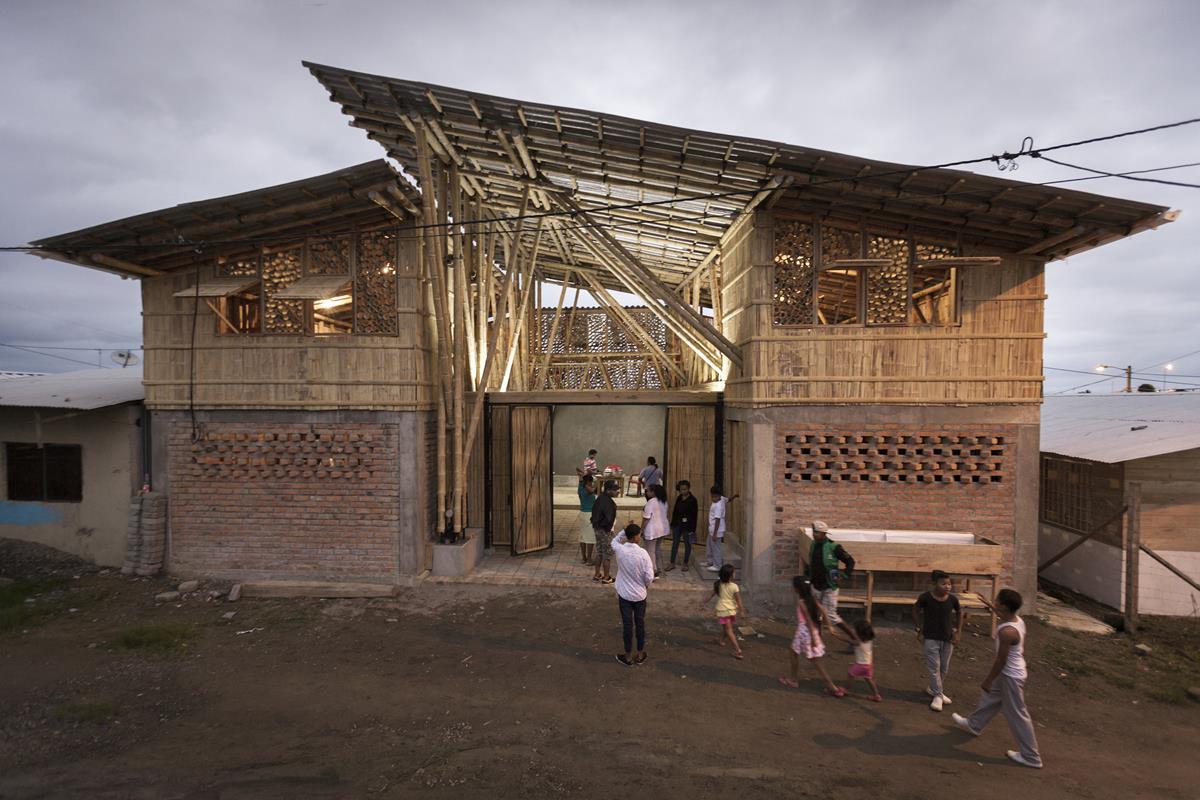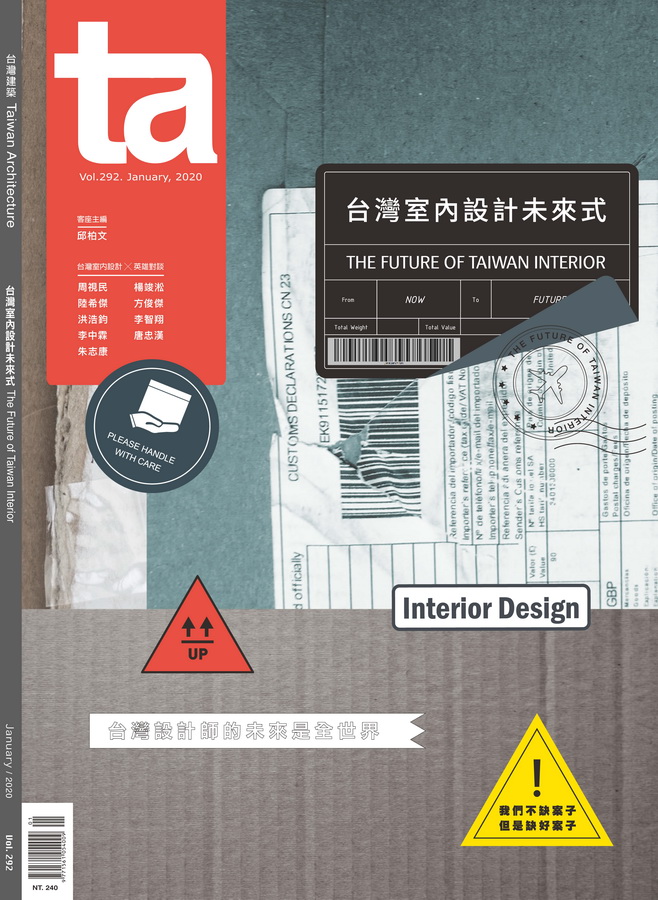查曼加文化中心Chamanga Cultural Center
共好×設計 Design for the Common Good 台灣建築雜誌2022年6月 Vol.321

作品檔案2093
查曼加文化中心Chamanga Cultural Center
團隊/Team:波特蘭州立大學、東京大學、慕尼黑應用科學大學、阿塔拉雅建築工坊、更多選項工作室/ Portland State University, University of Tokyo,
Munich University of Applied Sciences, Atarraya Taller de Arquitectura, Opción Más
網絡/ Network:設計實構交流網絡/ DesignBuildXchange;議題 Issue:教育/ Education
編輯/Editing:Shannon Turlington;翻譯/Translation:陳盈棻/Ying-Fen Chen
源自於2016年厄瓜多地震災後的救援與研究工作,查曼加文化中心的建造是學術界、市民組織與在地社區長期合作的成果。透過與在地社區和專業者的合作,來自不同國家的學生完成規畫、設計與建造,在一塊長15公尺、寬9公尺基地上,蓋出面積175平方米、高兩層樓的建築物。設計上參考了當地風土建築的特色,以融入當地的紋理,同時也透過尺度與傳統建築系統的重新詮釋,展現新的特色。在功能上,文化中心提供給當地合作社舉辦活動的空間,同時強化社區與在地歷史和環境的關係。
The Chamanga Cultural Center is the result of a long-term collaboration among academia, civil society organizations, and the community of Chamanga, Ecuador, starting with post-disaster relief efforts and research activities after the earthquake in 2016. The project was organized in two phases within a design/build framework, where students design, plan and build in collaboration with the local community and professionals. The result is a 175m2 two-story building located in a 9x15m2 lot. The Cultural Center anchors itself to its context by taking cues from local vernacular architecture, but it also stands out by means of its scale and reinterpreted use of traditional building systems. The center provides a place for local collectives to run their activities while strengthening the community’s ties to its history and the estuary.
理念
長期以來的邊緣化以及基礎設施的匱乏,讓查曼加面對重重的生態挑戰,而厄瓜多於2016年4月的一場地震,更加劇了諸如貧窮、水資源和廢棄物處理設施缺乏等困境。查曼加文化中心提供了社區各類活動的空間,來共同面對這些挑戰。由於空間有限,不同的活動、團體和情境,必須在非常侷限的空間中融合共存,此外空間在維持其開放性與彈性的同時,又得妥善協調並保持安全。透過一些建築策略,查曼加文化中心被設計成一個兼具耐震、環境友善並具有文化適切性的建築。
Cause
Historically marginalized and disconnected from water and sanitation systems, Chamanga faces multilayered ecological challenges. The earthquake that struck the coast of Ecuador in April 2016 accentuated challenges like poverty and lack of public water and waste infrastructure. The building facilitates community-run practices and activities that tackle these larger-scale challenges. A variety of activities, groups, and scenarios had to be incorporated in a fairly limited space; the project had to be open and flexible, yet well-tuned and safe. Several architectural strategies were devised to make this possible in an earthquake-resistant, environmentally friendly, and culturally appropriate configuration.
方法
此計畫致力於災後與社區長期的合作,並透過短期與中期有形的改善成果,來達成長遠的願景。過程中,在地夥伴「阿塔拉雅建築工坊」(Atarraya Taller de Arquitectur)和「更多選項工作室」(Opción Más)帶領廣大的利害關係人,進行田野調查、參與式決策和計畫執行。同時,阿塔拉雅更倡議透過公共討論,來制定方案與實際執行,並經由資源整合來產出成果,過程包含有議題界定和願景規劃的工作坊、發展適當分期策略的專家會議,以及替選方案評估的討論會。
Method
The project aims to material ize a long-term process of collaboration with the community after the earthquake. I t complements far-reaching visions with tangible improvements in the short and mid-term. Throughout the process, local partners Atarraya Taller de Arquitectura and Opción Más led on-site research, participatory decision-making, and implementation with a broad range of stakeholders. Atarraya advocated for public discussions of programming, execution, resources, and outcomes. These included problem-definition and visioning workshops, charettes to develop an adequate phasing strategy, and meetings to evaluate specific design alternatives.
影響
許多在地組織都在查曼加文化中心舉行過不同的文化、生態和經濟活動。其中,技能培力工作坊與技術訓練活動,呈現了中心於提升在地經濟機會上的量能;口述傳統與音樂工作坊,還有馬林巴琴課程,更是重建並強化傳統厄瓜多非裔和蒙圖比奧原鄉文化遺產的眾多活動之一。此外,中心也是許多社區行動的據點,在社群互助和團結上扮演重要的角色。在冠狀肺炎疫情大肆傳播期間,社區就以此為據點,生產出六千片口罩。
Impact
Many local organizations have used the Chamanga Cultural Center to host cultural, ecological, and economic activities. Skillbuilding workshops and technical training demonstrate the center’s capacity to strengthen collective economic opportunities. Oral tradition and music workshops, as well as marimba lessons, point to broader efforts to recover and strengthen traditional Afro-Ecuadorian and Montubio cultural heritage. The center also hosts community actions that aim at strengthening mutual aid networks and other forms of solidarity. An example of this was the fabrication of six thousand face masks during the COVID-19 pandemic.
提示
社區領袖在整個過程中提供知識交換的機會,將傳統互助式的建築技術(在厄瓜多稱為Minga),融入到設計/實構的教學方法中。這個過程確保最終產出的空間是適用的,也強化了社區主導與社群互惠的構築傳統。遠距計畫夥伴協調的難度,雖然使計畫變得複雜,但是透過「更多選項工作室」以及社區仲裁者的協助與聯繫,計畫最終得以成功。認可業主(社區)擔任「策展者」的角色,則有助於使營造過程也兼具社會功能。
Takeaways
The leadership of local maestros/maestras throughout the process provided opportunities for knowledge exchange, integrating the local tradition of social reciprocal construction—known in Ecuador as minga—with the academic methodology of design/build. This was crucial to ensure that the building was appropriate as well as to strengthen the community-organizing process that the construction was part of. Difficulties coordinating across distant project partners complicated this project. But making the community, Opción Más, and the site the final arbiters helped keep the project connected and ultimately successful. Acknowledging the client’s role as curator changed the nature of the process, allowing it to become as much a social as a construction process.
(完整作品內容請參考《台灣建築》2022年6月號,Vol.321)













